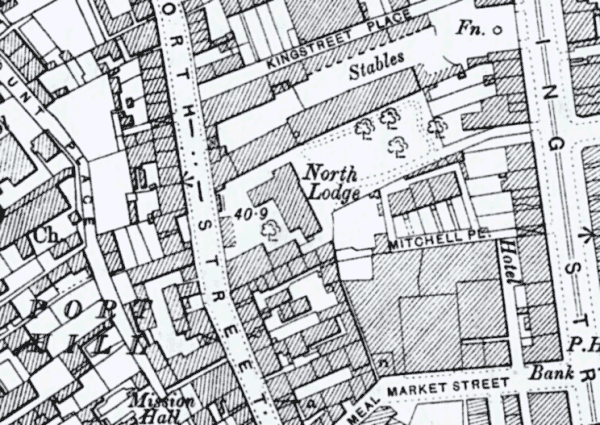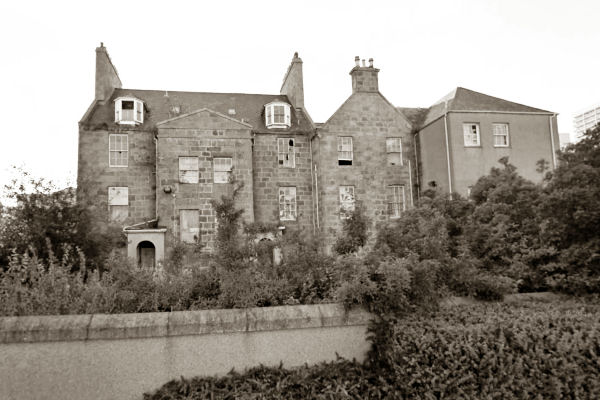Aberdeen Female School of Industry, Aberdeen, Aberdeenshire, Scotland
In October 1841, a School of Industry was founded in Aberdeen by Sheriff William Watson to provide education and training for boys involved in street begging, vagrancy and petty pilfering. On 5 June 1843, Watson opened an institution on similar lines for girls, the Female School of Industry, which occupied premises at Long Acre. On 19th May 1845, the establishment relocated to 61 Loch Street, Aberdeen.
In 1846, the Female School became embroiled in a dispute between different religious factions in the town. The School's management committee, which was dominated by members of the Free Church, decided to bar the girls from attending services at the Established Church in the town's East Parish. Sheriff Watson, himself a member of the Free West Church, voiced his support for the committee.
A split resulted, with the Free Church faction removing all but three of the girls to temporary accommodation in part of the Free South Church School on Charlotte Street, and adopting the name Sheriff Watson's Female School of Industry. The original School, initially having just three inmates, re-opened in July 1847 at Shaw's Court, Gallowgate, styling itself as the Aberdeen Female School of Industry. In around 1852, it moved to Walkers Court, 63 Guestrow.
In 1870, the crowded and closed-in Guestrow site was exchanged for the much larger and superior premises of North Lodge, 167 King Street, purchased for the sum of £1,650. The property consisted of a large house, formerly divided into two, with a large garden. The School was officially opened on 19th July 1870 and officially licensed as an Industrial School on December 16th of that year to house up to 100 girls aged from 7 to 13 at their date of admission. The superintendent was Miss Jane MacKay and the schoolmistress Miss H MacKay.
An inspection in 1871 recorded that the School had 131 inmates on its register, of whom 80 had been placed by the courts, the remainder being voluntary cases. The dormitories only contained 34 girls, with the remainder being lodged out with respectable people in the town. The girls did all the housework and washing and were also employed in needlework and knitting, with an eye to future employment in domestic service.
The School site is shown on the 1902 map below.

Female School of Industry site, Aberdeen, c.1902.

Former North Lodge Female School of Industry from the south-west, Aberdeen.
The buildings were extended in 1876 with the addition of a large classroom, dining-room, kitchen, sewing-room and dormitory.
In 1877, Miss Black briefly held the post of superintendent/matron then was succeeded by Miss Elizabeth Moffatt. Miss Welsh was now assistant matron.
In the early part of 1878, the school was attacked by typhus fever, and 37 children were affected, resulting in three deaths. The matron, Miss Moffatt, lost her life in the same epidemic. The sick were received in the Royal Infirmary and Epidemic Hospital, and the children were removed to a vacant hospital in the vicinity. Careful sanitary measures were adopted, the house thoroughly disinfected, and the children were able to return to North Lodge at the beginning of April.
Miss Moffatt was succeeded as matron by Miss Campbell, with Miss Hay as her assistant. Miss Hay replaced Miss Campbell as matron in 1885, assisted by Miss Taylor. In the same year, five of the girls emigrated. In 1887, Miss Falconer became matron.
An inspection in 1889 noted that a large hall, opening from the playground, was used on Sundays for "mothers' meetings", which the children, whose friends attended, were allowed to join. The inspector criticised this practice, suggesting that the influence of parents was unlikely to be beneficial. During that year, the girls had been to a house in the country for a holiday. They went in two detachments, each remaining there for about three weeks. It was also recorded that although the girls were trained with a view to domestic service, most of them on discharge go to work in factories. For the third year in succession the school had won the challenge shield presented by the National Physical Recreation Society for musical drill.
In 1891, Miss Helen Melvin had become matron, assisted by sister, Miss Mary Melvin.
Following a decline in the number of inmates at North Lodge and at the Whitehall Girls' Industrial School the two institutions were formally merged on January 1st 1903. The North Lodge School was closed and the girls transferred to the Whitehall site, which adopted the name of the Female School of Industry. The Misses Melvin also moved to Whitehall to continue in their roles as matron and assistant matron.
The North Lodge building survived until 2012 but has now been demolished.
Records
Note: many repositories impose a closure period of up to 100 years for records identifying individuals. Before travelling a long distance, always check that the records you want to consult will be available.
- None identfied at present — any information welcome.
Census
Bibliography
- Higginbotham, Peter Children's Homes: A History of Institutional Care for Britain's Young (2017, Pen & Sword)
- Mahood, Linda Policing Gender, Class and Family: Britain, 1850-1940 (1995, Univeristy of Alberta Press)
- Prahms, Wendy Newcastle Ragged and Industrial School (2006, The History Press)
Links
- None noted at present.
Except where indicated, this page () © Peter Higginbotham. Contents may not be reproduced without permission.


